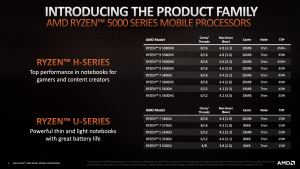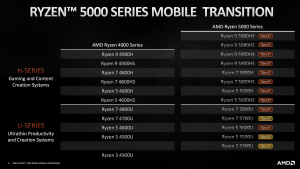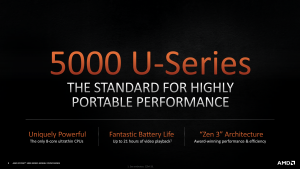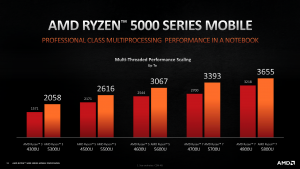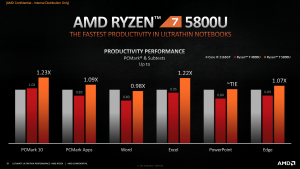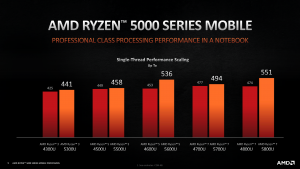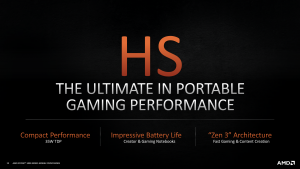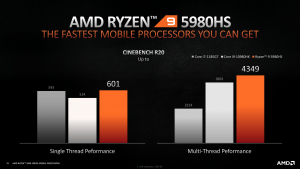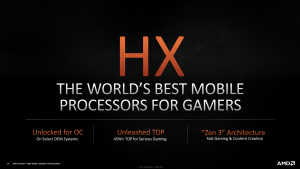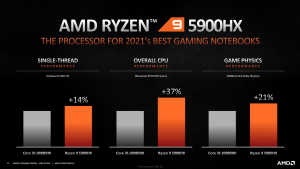After plenty of speculation, Lisa Su today officially announced AMD's Ryzen 5000 mobile processors at CES 2021. These new mobile parts are split between the more performant H-series and the lower-power U-series, scaling up to 8-core/16-thread parts that can push past a 45W TDP.
We've been hearing about Ryzen 5000 for mobile since before the Zen 3 architecture debuted last November, but it is now finally here. AMD announced eight H-series parts and five U-series parts, slotting into the familiar Ryzen 3, Ryzen 5, Ryzen 7 or Ryzen 9 naming conventions. For a very high level overview, all of the H-series parts are either 6C/12T or 8C/16T, with TDPs of at least 35W. The U-series parts range between 4C/8T to 8C/16T, but all are 15W parts.
As a curiosity, not all of the parts shown above are built on the Zen 3 architecture – all except the low-power Ryzen 3 5300U, Ryzen 5 5500U and the Ryzen 7 5700U, which remain on Zen 2. That means of the new U-series chips, only the Ryzen 5 5600U and Ryzen 7 5800U are Zen 3-based. A tell-tale sign for this point is the significantly higher cache capacity enjoyed by the Zen 3 options as compared to the Zen 2 parts.
That oddity seems to affect single-threaded performance most of all, as AMD's data shows increases of just 2-4% for the 5300U, 5500U and 5700U compared to their predecessors when looking at Cinebench R20. The Zen 3-based 5600U and 5800U, meanwhile, scored 18% and 16% better than their predecessors, respectively.
In terms of multi-core performance, the uplifts are bigger for the 5000 series, largely down to the fact that all five parts support SMT, which wasn't the case with the 4000 series. The 4C/8T 5300U, for instance, delivers a Cinebench R20 score that is 31% ahead of its 4C/4T predecessor, the 4300U. The 8C/16T 5800U betters the 8C/16T 4800U by a less impressive, but still decent, 14% margin.
For its higher power H-series, AMD has introduced a fair few more parts than was present with the previous generation, and there are new suffixes too, like the HX SKUs. It has the potential to get confusing, but every H-series SKU announced so far is built on the same 7nm process, Zen 3 architecture, and supports SMT. The main differences, aside from some being 6-core and others 8-core, come down to clocks and TDP. Every HS part has a lower TDP of 35W, and accordingly drops rated clock speed by up to 400MHz, though this varies from SKU to SKU.
As for the HX parts, this denotes a part can be overclocked, raising the TDP beyond 45W, depending on the system of course. The real-world difference between the 5900HX and the 5980HX, which are both 8C/16T parts, both overclockable, with the latter enjoying just a 200MHz rated boost clock advantage – remains to be seen.
Regardless, AMD clearly has confidence in its new parts, showing both the 35W Ryzen 9 5980HS and the 45W+ 5900HX out-scoring Intel's i9-10980HK in a few different workloads. Availability of Ryzen 5000-based mobile machines is slated for February.
Elsewhere, Lisa Su confirmed RDNA 2-based mobile GPUs will be coming 1H 2021.
Discuss on our Facebook page HERE.
KitGuru says: Ryzen 5000 for mobile is finally here, and there's more SKUs than I expected. What do you make of these new parts?
 KitGuru KitGuru.net – Tech News | Hardware News | Hardware Reviews | IOS | Mobile | Gaming | Graphics Cards
KitGuru KitGuru.net – Tech News | Hardware News | Hardware Reviews | IOS | Mobile | Gaming | Graphics Cards


